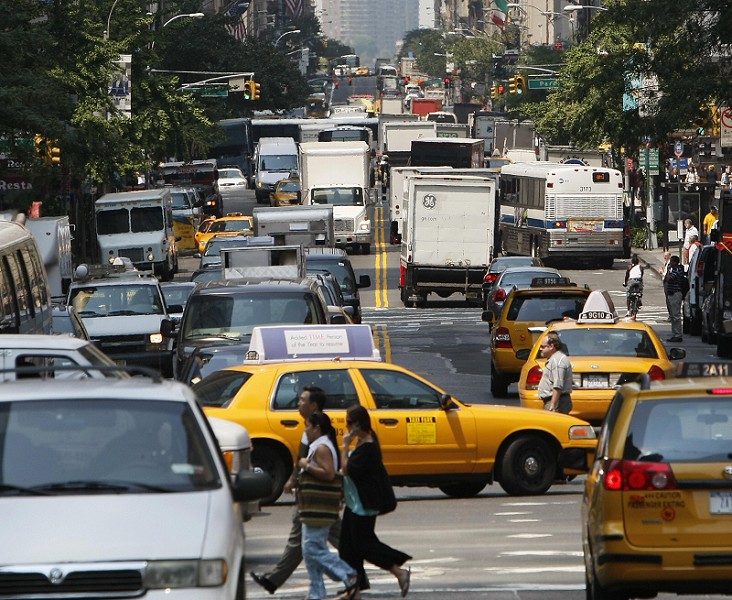An Hourly Fee on Cabs and Ubers Is Less Radical Than It Appears

With yellow taxis, Ubers, and other for-hire vehicles now comprising half of Manhattan traffic, there’s no way to thin out the mass of cars clogging New York’s most congested streets without putting a price on these types of trips.
Surcharges on for-hire vehicles traveling within the so-called Manhattan taxi zone, which extends to 96th Street on the east side and 110th Street on the west, are central to both the Move NY plan and the recommendations of Governor Cuomo’s Fix NYC panel.
Today, transportation analyst Bruce Schaller put a new spin on these proposals with a report that recommends charging for-hire vehicles between $5 and $50 per hour within the Manhattan taxi zone. Though that recommendation may appear radical, it’s better viewed as an addition to building blocks already assembled by Move NY and Fix NYC.
Regrettably, today’s Times exclusive branded Schaller’s proposal with the red-hot headline, “If Your Uber Ride Cost an Extra $50, Would You Still Take It?” The actual policy prescription is far different.
Schaller is calling for a surcharge of up to $50 per hour, not per ride. More importantly, by his estimation the $50 rate would apply to fewer than one percent of New York City for-hire trips — those confined to Central Midtown (Third Avenue to Eighth Avenue, 42nd Street to 60th Street) and occurring between 8 a.m. and 7 p.m. on weekdays. The rate would be lower in less congested areas, and during off-peak times of day.
It should also be noted that current TLC pricing already mandates up to $30 in “wait time” fare charges for any hour-long taxi ride, whether in the Manhattan CBD or not. Moreover, any trip with a $30 wait-time cost by definition occurs in hyper-congested traffic and thus is sticking other vehicle users, in the aggregate, with $200 in congestion costs, according to my modeling (which you can see in the BTA spreadsheet).
Here’s a snapshot of Schaller’s for-hire surcharge proposal:
From the right-most column, we calculate that for-hire trips that would be surcharged at a modest $5 an hour — all trips between 7 p.m. and 8 a.m., plus Saturdays and Sundays — would outnumber trips surcharged at Schaller’s top $50/hour rate by 72 to 1. Throwing in trips that never touch the Manhattan taxi zone and would therefore face no surcharge, trips surcharged at $5/hour or less would outnumber the $50/hour trips more than 100 to 1.
Once you put the high-end rate in Schaller’s proposal in context, you can better compare it to the for-hire surcharges in Fix NYC and Move NY.
Let’s start with Fix NYC. The governor’s panel laid out a matrix of 42 different options for surcharging for-hire (Figure 9 in the Fix NYC report). The surcharges vary from $2 to $5 per trip. But all 42 options have these two features in common: Only trips that touch the Manhattan taxi zone are surcharged, and the entire surcharge is placed on “the drop” — the charge to enter the vehicle — so the surcharge doesn’t vary by trip distance or duration.
Unlike Fix NYC, Move NY exempts the drop in favor of a time-based charge like Schaller’s, in this case set at $12 per hour for all taxi-zone travel during peak hours (weekdays, 6 a.m. – 8 p.m.), and $6/hour at other times. While that works out to a lower average rate than what Schaller is proposing, Move NY’s surcharges also include a mileage charge, not just a time charge. Other details make it tricky to compare the two sets of proposals, though on the whole Schaller’s is somewhat steeper than Move NY’s.
Perhaps the key distinction is that Schaller is more aggressive in charging time that vehicles spend “cruising” — driving without a fare. Schaller would apply per-hour rates to all cruising by Uber, Lyft, and similar services, and to cruising by yellow taxis above some base level. Move NY, by contrast, would exempt yellows from cruising charges, in recognition of their medallion investments in what had always been a regulated cartel, while charging Ubers and other app-based services for cruising minutes (and miles) at 25 percent of the rates applied to fares.
If the details are making your head spin, here are the main takeaways from the Schaller and Fix NYC reports:
- Surcharging for-hire vehicles per minute (or per minute and per mile) is superior to charging only on the drop, both in terms of traffic reduction and economic fairness.
- Technology to charge for-hire vehicles’s in that fashion is readily available and could be mandated for congestion pricing’s initial phase.
- The precise rates are less important than the commitment to institute a rational surcharge system.
Other ideas advanced by Schaller may also hold promise, including minute-based charging for trucks, which could begin on a voluntary basis as an opt-in alternative to the cordon fee.
With congestion pricing approaching the decision point in Albany, advocates warned the Times that Schaller’s surcharge idea “could take the focus away from” the further-along Move NY and Fix NYC plans. That need not be the case, however, and Schaller’s contributions are worth pursuing.
Advocates should help Albany get past the $50 red herring and move forward on congestion pricing legislation, including the for-hire vehicle component. If a bill can be introduced this month, there will be ample time to hammer out the for-hire vehicle policy that can do the most good with the least harm.






